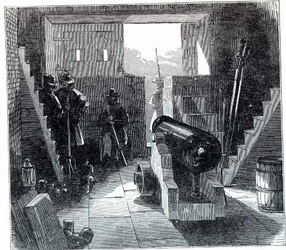Civil War
Fort Sumter
On April 11, 1861, Beauregard sent three aides, Colonel James Chesnut, Jr., Captain Stephen D. Lee, and Lieutenant A. R. Chisolm to demand the surrender of the fort. Anderson declined, and the aides returned to report to Beauregard. After Beauregard had consulted the Secretary of War, Leroy Walker, he sent the aides back to the fort and authorized Chesnut to decide whether the fort should be taken by force. The aides waited for hours while Anderson considered his alternatives and played for time. At about 3 a.m., when Anderson finally announced his conditions, Colonel Chesnut, after conferring with the other aides, decided that they were "manifestly futile and not within the scope of the instructions verbally given to us". The aides then left the fort and proceeded to the nearby Fort Johnson. There, Chesnut ordered the fort to open fire on Fort Sumter.
On April 12, 1861, at 4:30 a.m., Confederate batteries opened fire, firing for 34 straight hours, on the fort.Edmund Ruffin, noted Virginian agronomist and secessionist, claimed that he fired the first shot on Fort Sumter. His story has been widely believed, but Lieutenant Henry S. Farley, commanding a battery of two mortars on James Island fired the first shot at 4:30 A.M. (Detzer 2001, pp. 269–71). The garrison returned fire, but it was ineffective, in part because Major Anderson did not use the guns mounted on the highest tier, the barbette tier, where the gun detachments would be more exposed to Confederate fire. On April 13, the fort was surrendered and evacuated. During the attack, the Union colors fell. Lt.Norman J. Hall risked life and limb to put them back up, burning off his eyebrows permanently. No Union soldiers died in the actual battle though a Confederate soldier bled to death having been wounded by a misfiring cannon. One Union soldier died and another was mortally wounded during the 47th shot of a 100 shot salute, allowed by the Confederacy. Afterwards the salute was shortened to 50 shots. Accounts, such as in the famous diary of Mary Chesnut, describe Charleston residents along what is now known as The Battery, sitting on balconies and drinking salutes to the start of the hostilities. The Fort Sumter Flag became a popular patriotic symbol after Major Anderson returned North with it. The flag is still displayed in the fort's museum.
On April 12, 1861, at 4:30 a.m., Confederate batteries opened fire, firing for 34 straight hours, on the fort.Edmund Ruffin, noted Virginian agronomist and secessionist, claimed that he fired the first shot on Fort Sumter. His story has been widely believed, but Lieutenant Henry S. Farley, commanding a battery of two mortars on James Island fired the first shot at 4:30 A.M. (Detzer 2001, pp. 269–71). The garrison returned fire, but it was ineffective, in part because Major Anderson did not use the guns mounted on the highest tier, the barbette tier, where the gun detachments would be more exposed to Confederate fire. On April 13, the fort was surrendered and evacuated. During the attack, the Union colors fell. Lt.Norman J. Hall risked life and limb to put them back up, burning off his eyebrows permanently. No Union soldiers died in the actual battle though a Confederate soldier bled to death having been wounded by a misfiring cannon. One Union soldier died and another was mortally wounded during the 47th shot of a 100 shot salute, allowed by the Confederacy. Afterwards the salute was shortened to 50 shots. Accounts, such as in the famous diary of Mary Chesnut, describe Charleston residents along what is now known as The Battery, sitting on balconies and drinking salutes to the start of the hostilities. The Fort Sumter Flag became a popular patriotic symbol after Major Anderson returned North with it. The flag is still displayed in the fort's museum.



